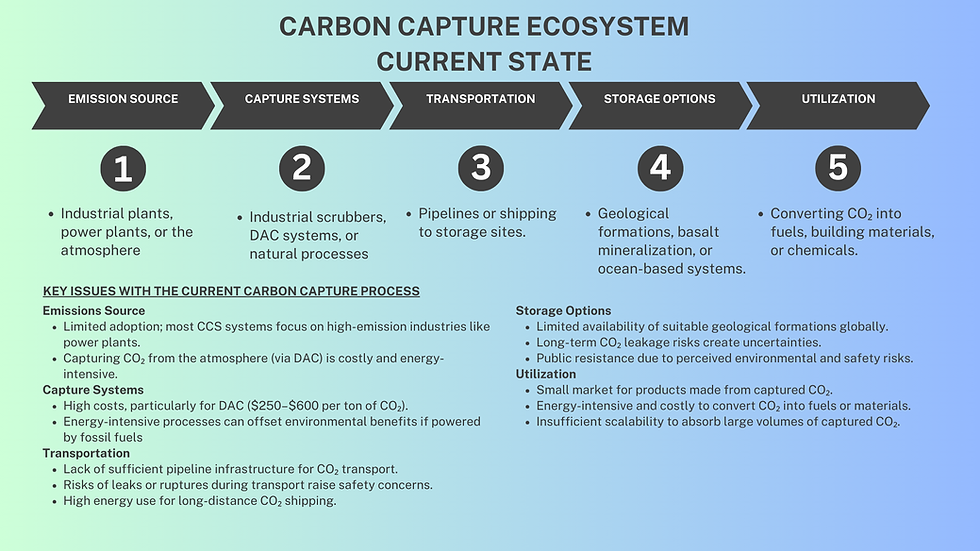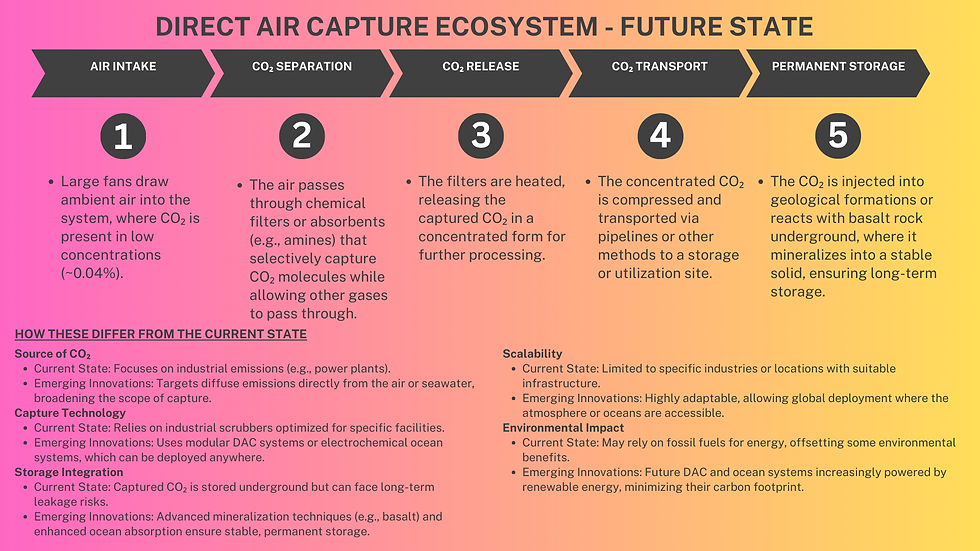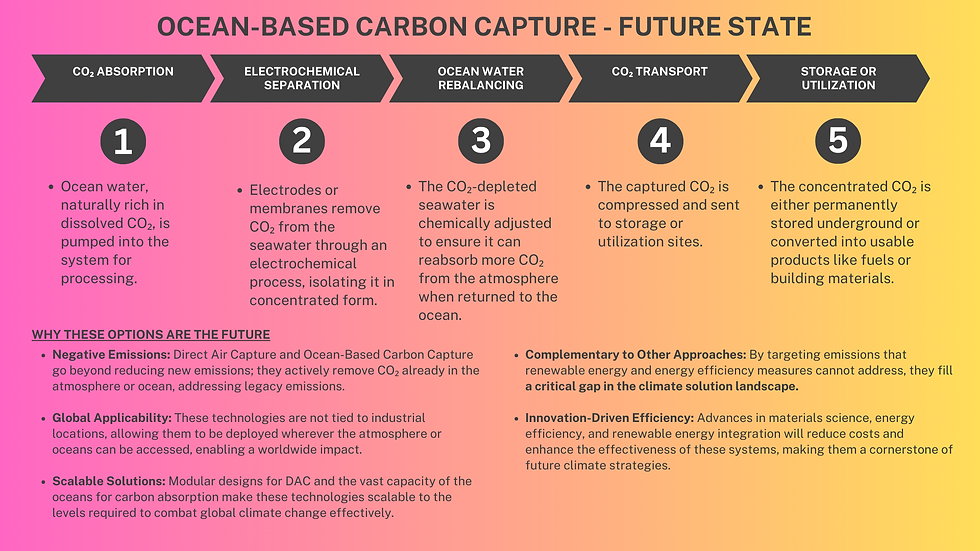The Power of Carbon Capture Technology: A Small Step with Big Potential
- Alvin Lourdes

- Jan 8
- 3 min read
January 2025
Climate change is one of the most urgent challenges humanity faces. From rising sea levels to extreme weather and biodiversity loss, the impacts are already evident. While the scale of the problem is immense, carbon capture and storage (CCS) technology offers a targeted solution. By focusing on capturing and storing carbon dioxide (CO₂) emissions, CCS addresses one of the root causes of climate change directly.
In this post, I’ll dive into how CCS works, explore current implementations, discuss emerging innovations, and reflect on its broader implications for humanity and the planet.

What is Carbon Capture and Storage?
Carbon capture and storage (CCS) is a technology designed to prevent CO₂ from entering the atmosphere or remove it after it has been emitted. It consists of three primary steps:
Capture: CO₂ is separated from other gases produced by industrial processes or directly extracted from the air.
Transport: The captured CO₂ is transported, typically via pipelines, to storage sites.
Storage: The CO₂ is injected deep underground into geological formations such as depleted oil and gas reservoirs or saline aquifers.
Current Applications of Carbon Capture Technology
Petra Nova Project (USA) The Petra Nova project in Texas is one of the world’s largest operational CCS facilities. It captures CO₂ from a coal-fired power plant and uses the captured CO₂ for enhanced oil recovery (EOR), a process where CO₂ is injected into oil reservoirs to extract additional crude oil. The project has successfully reduced emissions from the plant by over 90%.
Sleipner Gas Field (Norway) Operated by Equinor, the Sleipner Gas Field is a pioneering CCS project that has been operational since 1996. It captures CO₂ from natural gas production and injects it into a saline aquifer beneath the seabed. This project has stored over 20 million tonnes of CO₂, demonstrating the long-term feasibility of geological storage.
Emerging Innovations in Carbon Capture
Direct Air Capture (DAC) by Climeworks (Switzerland) Climeworks is a leader in DAC technology, using modular machines to remove CO₂ directly from the atmosphere. Their Orca plant in Iceland combines DAC with underground storage, where CO₂ reacts with basalt rock and turns into stone, ensuring permanent removal from the atmosphere.
Ocean-Based Carbon Capture New research is exploring the potential of enhancing the ocean’s natural ability to absorb CO₂. Technologies under development aim to use electrochemical processes to remove CO₂ from seawater, effectively turning the ocean into a giant carbon sink without harming marine life.


Why Carbon Capture is Needed
Despite progress in renewable energy adoption, global emissions remain dangerously high. CCS addresses the following critical challenges:
Hard-to-Decarbonize Industries Sectors like cement, steel, and chemical manufacturing rely on processes that inherently emit CO₂. CCS provides a way to mitigate these emissions without halting production.
Legacy Emissions Even if all emissions stopped today, the CO₂ already in the atmosphere would continue to warm the planet. Technologies like DAC offer a way to clean up this “climate debt.”
Complement to Renewables While renewable energy reduces future emissions, CCS tackles existing and ongoing emissions, providing a necessary bridge as the world transitions to a low-carbon economy.
Emerging Controversies
Carbon capture is not without its critics, and several debates surround its implementation:
Cost vs. Impact Critics argue that CCS is expensive and may divert resources from renewable energy development. CCS infrastructure requires substantial investment, raising questions about its cost-effectiveness.
Moral Hazard Some worry that CCS enables industries to delay meaningful decarbonization by offering a technological “escape hatch.” This can lead to complacency rather than a systemic shift toward sustainability.
Carbon Tax Debate The adoption of CCS often relies on carbon pricing mechanisms like a carbon tax. While proponents see this as an effective incentive, opponents argue it disproportionately impacts low-income populations and certain industries.
How Humanity Benefits
Healthier Living Conditions By reducing CO₂ emissions, CCS helps improve air quality and mitigate the health risks associated with air pollution.
Economic Growth in Green Industries CCS projects generate jobs in engineering, construction, and maintenance, contributing to local economies while fostering innovation.
Climate Stability Capturing and storing CO₂ on a large scale helps slow the pace of global warming, providing a more stable climate for future generations.
A Personal View
Carbon capture technology represents the ingenuity of humanity in the face of a crisis. For me, its promise lies not only in its ability to reduce emissions but also in its potential to inspire a collective sense of responsibility. Climate change demands a variety of solutions, and CCS is one piece of that puzzle—a critical one. I believe in the necessity of exploring and investing in every viable path to ensure a livable future for all.

Comments